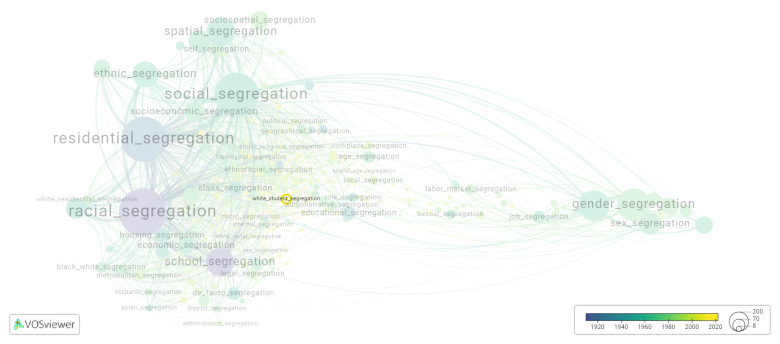White student segregation: Difference between revisions
(Creating page) |
(Creating page) |
||
| (One intermediate revision by the same user not shown) | |||
| Line 18: | Line 18: | ||
[[File:white_student_segregation.png|780x780px]] | [[File:white_student_segregation.png|780x780px]] | ||
This visualization is based on the study [[Segregation_Wiki:About| The Multidisciplinary Landscape of Segregation Research]]. | |||
For the complete network of | For the complete network of interrelated segregation forms, please refer to: | ||
* | * [https://tinyurl.com/2235lkhw First year of publication] | ||
* | * [https://tinyurl.com/2d8wg5n3 Louvain clusters] | ||
* | * [https://tinyurl.com/223udk5r Betweenness centrality] | ||
* | * [https://tinyurl.com/244d8unz Disciplines in which segregation forms first emerged (Scopus database).] | ||
==References== | ==References== | ||
==Notes== | ==Notes== | ||
Latest revision as of 07:17, 16 October 2024
Date and country of first publication[1][edit | edit source]
2021
United States
Definition[edit | edit source]
White student segregation refers to the separation of white students from students of other races or ethnicities within a educational institution. This can occur through policies or practices that intentionally or unintentionally create separate spaces or classrooms for white students. White student segregation can result from racial or economic disparities within a school district or from deliberate efforts to ensure that white students are not integrated with students of other races.
Historically, white student segregation has been linked to racial discrimination and inequality, particularly during the era of racial segregation in the United States. The landmark Supreme Court case, Brown v. Board of Education of Topeka, ruled that racial segregation in public schools was unconstitutional in 1954. However, de facto segregation persisted through various means, such as discriminatory housing practices or the creation of specialized schools or programs that overwhelmingly enrolled white students.
White student segregation can have negative effects on the education and well-being of both white students and students of other races. It can perpetuate racial and economic inequalities, limit exposure to diverse perspectives and experiences, and impede efforts to promote equal opportunities in education.
Efforts to address white student segregation may include implementing policies to promote diversity and integration, providing resources and support to underserved communities, and fostering inclusive and equitable school environments. These efforts can help create a more equitable and inclusive educational system for all students.
See also[edit | edit source]
Related segregation forms[edit | edit source]
White student segregation is frequently discussed in the literature with the following segregation forms:
This visualization is based on the study The Multidisciplinary Landscape of Segregation Research.
For the complete network of interrelated segregation forms, please refer to:
References[edit | edit source]
Notes[edit | edit source]
- ↑ Date and country of first publication as informed by the Scopus database (December 2023).
At its current state, this definition has been generated by a Large Language Model (LLM) so far without review by an independent researcher or a member of the curating team of segregation experts that keep the Segregation Wiki online. While we strive for accuracy, we cannot guarantee its reliability, completeness and timeliness. Please use this content with caution and verify information as needed. Also, feel free to improve on the definition as you see fit, including the use of references and other informational resources. We value your input in enhancing the quality and accuracy of the definitions of segregation forms collectively offered in the Segregation Wiki ©.
White student segregation appears in the following literature[edit | edit source]
Wilson E.K. (2021). Monopolizing whiteness. Harvard Law Review, 134(7), 2383-2448. Harvard Law Review Association.https://doi.org/10.2139/ssrn.3688628

